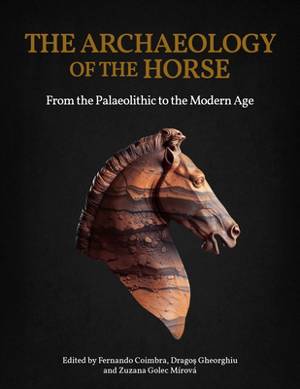
- Retrait gratuit dans votre magasin Club
- 7.000.000 titres dans notre catalogue
- Payer en toute sécurité
- Toujours un magasin près de chez vous
- Retrait gratuit dans votre magasin Club
- 7.000.0000 titres dans notre catalogue
- Payer en toute sécurité
- Toujours un magasin près de chez vous
The Archaeology of the Horse
From the Palaeolithic to the Modern Age
Livre broché | Anglais
104,45 €
+ 208 points
Description
The horse has a strong presence in archaeology. Its relationship with past human beings has great diversity, which can be analysed through economic, social, artistic and mythological aspects. This book, the outcome of a session at the European Association of Archaeologists' Annual Meeting in Rome in 2024, focuses on a variety of different aspects about the archaeology of the horse, such as its presence in prehistoric rock art and sculpture, antiquity and medieval art, the domestication process, the use of the horse for riding and traction, its use in funerary rituals, symbolism and presence in myths in diverse societies, among other themes.
In the Palaeolithic, this animal was not only a source of meat for nourishment, but it appears in the origins of artistic representations through paintings and carvings on cave walls and on open air outcrops. The domestication process included the use of mare's milk, which is rich in proteins and carbohydrates, being low in fat, and having a high content in vitamin C, making it better than cow's milk. When horses started to be ridden people could travel faster, developing trade and communication, disclosing cultural issues. With the emergence of complex societies, the horse was used in hunting, as a 'war machine' and as a symbol of social status. Iconography available in a variety of archaeologically visible media such as rock art, sculptures, numismatics, mosaics, and frescoes, among other artistic manifestations, enables us to understand better the importance of the horse in the development of civilisation.
The book seeks to go beyond previous publications about the horse, which usually do not encompass prehistoric cultures, are often geographically limited, or focus on physical characteristics of the horse in battle or on descriptions of horse equipment with a lack of scientific archaeological context. The chapters presented here engage with the human-horse relationship on a variety of levels and at different time periods, with an emphasis on the social and cultural significance of the horse, zooarchaeological evidence, the role of horses in combat and ritual contexts and the relationship between horse and rider in iconography, art and burial rites.
In the Palaeolithic, this animal was not only a source of meat for nourishment, but it appears in the origins of artistic representations through paintings and carvings on cave walls and on open air outcrops. The domestication process included the use of mare's milk, which is rich in proteins and carbohydrates, being low in fat, and having a high content in vitamin C, making it better than cow's milk. When horses started to be ridden people could travel faster, developing trade and communication, disclosing cultural issues. With the emergence of complex societies, the horse was used in hunting, as a 'war machine' and as a symbol of social status. Iconography available in a variety of archaeologically visible media such as rock art, sculptures, numismatics, mosaics, and frescoes, among other artistic manifestations, enables us to understand better the importance of the horse in the development of civilisation.
The book seeks to go beyond previous publications about the horse, which usually do not encompass prehistoric cultures, are often geographically limited, or focus on physical characteristics of the horse in battle or on descriptions of horse equipment with a lack of scientific archaeological context. The chapters presented here engage with the human-horse relationship on a variety of levels and at different time periods, with an emphasis on the social and cultural significance of the horse, zooarchaeological evidence, the role of horses in combat and ritual contexts and the relationship between horse and rider in iconography, art and burial rites.
Spécifications
Parties prenantes
- Editeur:
Contenu
- Nombre de pages :
- 240
- Langue:
- Anglais
Caractéristiques
- EAN:
- 9798888572269
- Date de parution :
- 22-05-26
- Format:
- Livre broché
- Format numérique:
- Trade paperback (VS)
- Dimensions :
- 170 mm x 239 mm

Les avis
Nous publions uniquement les avis qui respectent les conditions requises. Consultez nos conditions pour les avis.





